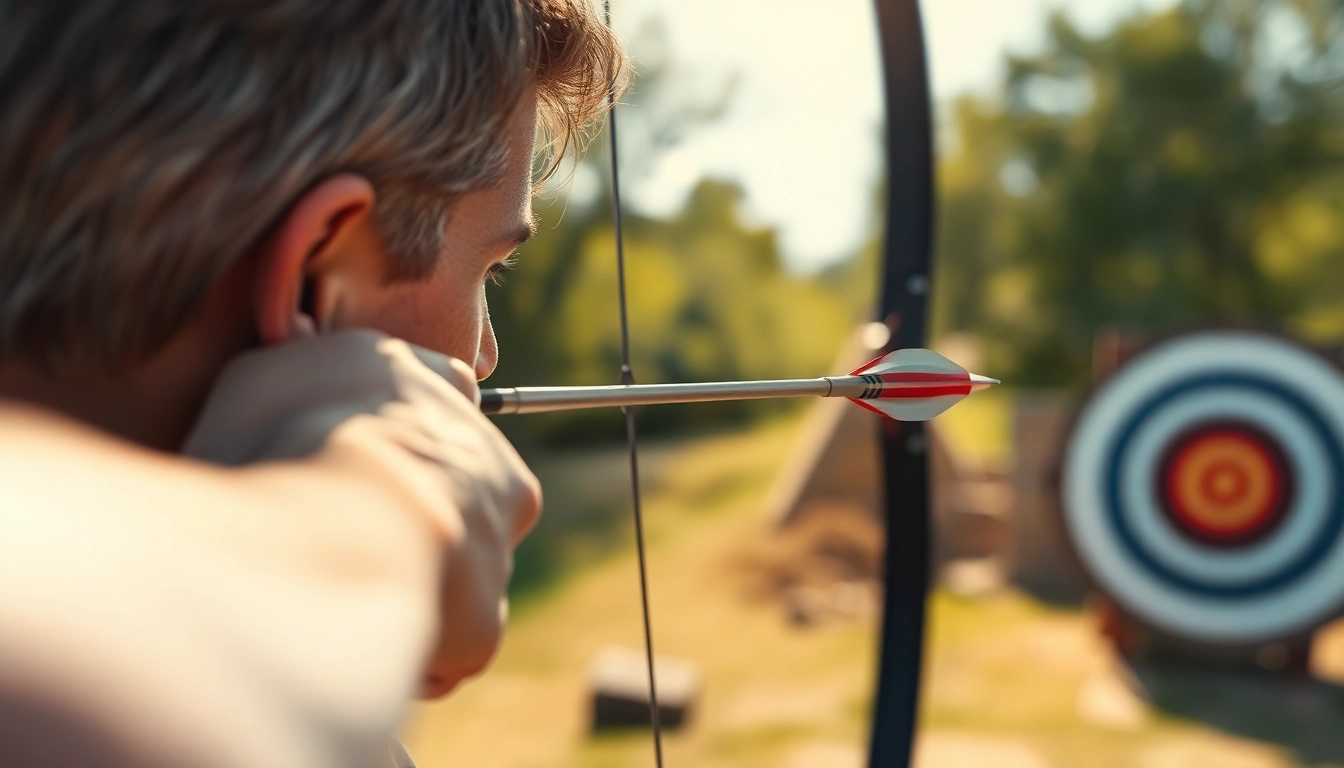Understanding Arrow Speed
Defining Arrow Speed and Its Importance
Arrow speed refers to the velocity at which an arrow travels once it is released from a bow. This measurement is critical for archers, as it directly impacts the arrow’s accuracy, trajectory, and overall performance. The importance of understanding arrow speed lies in the fact that it influences several key factors in archery, including the distance an arrow can travel effectively, how well it penetrates a target, and its impact on the overall hunting or competitive experience.
For instance, a faster arrow typically has a flatter trajectory, minimizing the effects of environmental factors such as wind and gravity. Consequently, being able to calculate and optimize arrow speed can lead to improved accuracy, greater kinetic energy upon impact, and enhanced effectiveness during hunting. Understanding this concept enables archers to make informed decisions about their equipment and shooting techniques.
Factors Influencing Arrow Speed
Several factors contribute to the speed of an arrow, each playing a pivotal role in its performance:
1. Bow Specifications: The type of bow used significantly influences the arrow’s speed. Different bows, such as compound, recurve, or longbow, have varying mechanisms for energy transfer to the arrow.
2. Draw Weight: This refers to the amount of force required to pull back the bowstring. A higher draw weight typically generates more energy, which translates to a faster arrow speed.
3. Arrow Weight: Heavier arrows will usually travel slower than lighter arrows, given the same draw weight. The trade-off between arrow weight and speed is essential for maximizing accuracy and power.
4. Arrow Length: Shorter arrows may achieve greater speeds due to reduced air resistance, while longer arrows can have improved stability.
5. Bowstring and Components: The type of bowstring, including its material and diameter, as well as other components such as stabilizers and dampeners, can impact the efficiency of energy transfer.
6. Environmental Conditions: Factors like altitude, temperature, and air density can also affect arrow speed. For example, arrows may fly faster in thinner air found at higher altitudes.
Understanding these factors is vital in optimizing arrow speed for a specific situation, whether for hunting, target practice, or competition.
Common Misconceptions About Arrow Speed
There are several misconceptions surrounding arrow speed that can mislead archers:
1. Faster is Always Better: Many assume that a faster arrow is always superior. However, ideal arrow speed balances velocity and weight for desired performance.
2. More Draw Weight Equals More Speed: While increased draw weight can provide more energy, it also requires greater physical strength from the archer. Overextending one’s capabilities can lead to poor shooting form and accuracy.
3. All Arrows Are Created Equal: People often think arrow material and design do not matter. In reality, the construction material (carbon, aluminum, etc.) and the arrow design significantly influence the final speed and trajectory.
4. Chronographs Are Necessary for Measurement: While chronographs provide precise readings, calculations using formulas can give relatively accurate estimations of arrow speed without specialized equipment.
Addressing these misconceptions can help archers make more informed decisions about their gear and how they approach the sport.
Using the Arrow Speed Calculator
Step-by-Step Guide to the Calculation
Using an Arrow Speed Calculator simplifies the process of determining the speed of your arrow. Here’s a step-by-step guide to using these calculators effectively:
1. Gather Your Equipment Data: Before starting, collect data on your bow’s specifications, draw weight, and arrow details, including weight and length.
2. Select the Correct Input Fields: Most calculators will have specific fields for inputting your draw weight, arrow weight, and sometimes the type of bow being used. Ensure to fill in all required fields for accurate results.
3. Input Your Values: Enter the values you’ve collected into the respective fields. Pay close attention to units (grains for arrow weight, pounds for draw weight) to avoid errors in your calculations.
4. Review Additional Parameters: Some calculators may offer additional parameters, such as arrow length or broadhead weight. Adjust these if relevant for your setup.
5. Calculate and Interpret the Results: Click the calculate button and review your results. The calculator will display the estimated arrow speed which can also include kinetic energy and momentum if applicable.
6. Analyze the Output: Take note of the speed and other metrics provided. This information can help you adjust your bow setup or arrow choice for optimal performance.
Following this structured approach allows for more effective use of the calculator and greater insights into your archery setup.
Parameters Required for Accurate Results
To achieve precise calculations from an Arrow Speed Calculator, a few critical parameters must be included:
– Arrow Weight: This is typically measured in grains and directly impacts how fast the arrow travels when shot from the bow.
– Bow Draw Weight: The force in pounds required to pull back your bowstring. It’s crucial for determining how much energy is transferred to the arrow.
– Bow Type: Not all bows perform similarly. Indicating the type of bow can help in obtaining tailored speed calculations based on design characteristics.
– Arrow Length: Knowing the specific length of the arrow can aid in factors related to drag and stability during flight.
Understanding these parameters helps ensure that the results produced are accurate and reflective of your specific equipment setup.
Interpreting the Results from the Calculator
Once the calculator has provided the results, the interpretation of these figures can be crucial for archers aiming to optimize their performance:
1. Speed in fps (feet per second): This is the main output. A higher value correlates with better distance and accuracy during flight. Knowing your optimal speed, archer can plan their shoots and target distances accordingly.
2. Kinetic Energy: This value indicates the energy an arrow carries upon impact, which plays a significant role in penetration. Higher kinetic energy values generally yield better penetration into targets.
3. Momentum: This figure represents the mass of the arrow multiplied by its speed. Greater momentum often translates to more significant impact upon hitting a target, making it a crucial figure for hunting applications.
By examining these results, archers can make informed decisions regarding their setups or further adjustments to their shooting techniques.
Enhancing Arrow Performance
Arrow Weight and Its Impact on Speed
Arrow weight is a foundational element that can significantly influence not only the speed of the arrow but also its performance in various scenarios. A heavier arrow will generally travel slower than a lighter one, given the same energy input. However, this relationship is not linear, and archers need to consider several factors:
1. Trajectory Control: Heavier arrows tend to have a more stable flight path, making them less susceptible to wind drift. They also maintain speed better over longer distances, which is essential for high accuracy.
2. Kinetic Energy and Impact: The kinetic energy of an arrow is partly determined by its weight. Heavier arrows can deliver more energy on impact, leading to deeper penetration in targets, which is crucial for hunting purposes.
3. Stability in Flight: An arrow that is too light may become erratic in its flight due to environmental factors. Striking the right balance between speed and stability is essential for effective archery performance.
Archers should assess their goals—whether they are hunting or target shooting—and choose their arrow weight accordingly to maximize performance.
Adjusting Bow Setup for Optimal Speed
Optimizing arrow speed often requires adjustments to the bow setup itself. Here are key areas where modifications can enhance performance:
1. Draw Weight Adjustment: Increasing the draw weight of your bow can lead to higher arrow speeds. However, it must be done within the archer’s capability to maintain form and consistency.
2. Bowstring Selection: The type of bowstring can also impact the speed of the arrow. Lighter, more efficient strings can facilitate faster speeds and better energy transfer to the arrow.
3. Tuning the Bow: Ensuring the bow is properly tuned, meaning everything from the rest to the nocking point is aligned correctly, can significantly impact arrow launch conditions, aiding in achieving optimum speed.
4. Branch and Limb Configuration: The design of the bow’s limbs influences how energy is stored and released. If the limbs are stiffer or utilize advanced materials, they may propel the arrow faster.
5. Stabilizers and Accessories: Adding or adjusting stabilizers can help improve control and balance, contributing to better aim and consistency, ultimately aiding in faster…
Each of these modifications needs careful consideration to prevent loss of accuracy or overexertion of the archer.
Examining the Role of Aerodynamics
Aerodynamics plays an essential role in how an arrow travels through the air, influencing its speed and stability. Key factors include:
1. Fletching Design: Fletchings stabilize the arrow during flight. Different designs (height, shape, and material) can alter drag, affecting speed and stability. Lower drag means higher speed.
2. Arrow Shaft Material and Finish: The arrow’s material, along with its finish, can influence its aerodynamic profile. A smoother finish reduces drag.
3. Broadhead Design: If hunting arrows are used, the design of the broadhead can have a substantial impact on how air flows around the arrow once released. A well-designed broadhead will reduce drag.
4. Arrow Length and Diameter: Longer and wider arrows create more surface area, which can increase drag. Opting for an optimal diameter based on the shooting conditions can help enhance speed without compromising stability.
Through understanding and optimizing these aerodynamic properties, an archer can improve their distance, accuracy, and overall shooting experience.
Comparing Speed Calculators
Identifying Reliable Arrow Speed Calculators
With many available online tools, choosing a reliable arrow speed calculator is key to obtaining accurate measurements. Assessing their features and methodologies can help in selecting the best tool for your needs.
1. User Reviews and Community Feedback: Consult forums and archery community groups for recommendations on the most reliable calculators based on user experiences.
2. Accuracy: Some calculators implement advanced physics models, while others use simplified formulas. Selecting those that offer validated methods leads to better reliability.
3. User-Friendly Features: A good calculator should be easy to navigate and not overwhelm the user with technical jargon. It should provide intuitive input fields and clear output.
4. Data Transparency: Reliable calculators often provide information on how they derive their results, improving trust in their outputs.
By understanding these factors, archers can make informed decisions about which tools will best serve their needs.
Evaluating Features of Different Calculators
When comparing various arrow speed calculators, consider the following vital features that contribute to utility and performance:
1. Input Parameters: Evaluating the range of input parameters each calculator accepts will determine how comprehensive it can be in assessing performance.
2. Additional Outputs: Check if the calculator provides metrics beyond speed, such as kinetic energy and momentum, which can be crucial for hunting setups and performance assessments.
3. Mobile Compatibility: For archers who are often on the move, ensuring the calculator is mobile-friendly or has an app version can be a significant advantage.
4. Help Guides and Tutorials: Some calculators provide guides to help users understand how to input data correctly and interpret results, making it easier for novices to navigate.
Tracking all these features will help users choose the calculator that suits them best, enhancing their overall archery experience.
Best Practices for Using Online Tools
To maximize the benefits of online arrow speed calculators, follow these best practices:
1. Regular Calibration: Ensure that the parameters you input are consistently aligned with your current bow and arrow setup. Re-evaluating after significant changes in equipment can lead to more accurate measurements.
2. Cross-Check Results: Whenever possible, cross-reference the results with other tools or methods, such as using a chronograph, to validate the accuracy of the calculator used.
3. Be Mindful of Assumptions: Understand the assumptions behind the calculator’s model and ensure they align with your shooting scenario. Each calculator may have varying definitions of “arrow speed” based on the methods used.
4. Stay Up-to-Date: Technologies and methods in archery constantly evolve. Keeping abreast of improvements in calculator tools ensures leveraging the best options available.
Using these practices can significantly enhance the reliability of calculated arrow speed and the overall utility of the calculators utilized.
Practical Applications of Arrow Speed Data
Using Speed Data in Field Settings
Understanding and applying arrow speed data during field scenarios enhances an archer’s effectiveness and preparedness. Here’s how:
1. Shooting at Varying Distances: With speed data in hand, archers can adjust their aiming points according to the distance to a target, reducing error and improving accuracy.
2. Penetration Considerations: Hunt planning often leans heavily on understanding necessary speed for effective penetration at given distances, aiding in selecting the right arrow weight and broadhead.
3. Wind and Environmental Adjustments: Knowing the arrow’s speed allows archers to better account for wind drift, improving their aim under various environmental conditions.
4. Real-Time Adjustments: Having arrow speed data aids in making quick adjustments while on the field, improving shooting outcomes based on immediate environmental observations.
Optimizing the use of arrow speed data fundamentally enhances on-field efficiency and outcome quality.
How Arrow Speed Affects Accuracy
Arrow speed is intrinsically linked to accuracy, influencing how precisely an arrow can hit its intended target. Here’s how speed impacts accuracy:
1. Trajectory Flatness: Faster arrows contribute to a flatter trajectory, making it easier to hit targets, especially at greater distances. The less time an arrow spends in flight, the lesser the impact of variables like wind.
2. Reaction to Environmental Factors: Higher speed can diminish the effects of challenging conditions like wind and turbulence, contributing to greater shot precision.
3. Follow-Up Shots: In a hunting or competition scenario, speed translates to quicker follow-up shots. The time spent between shots reduces as the arrow travels faster, enabling quicker addressing of subsequent shots.
4. Consistent Release and Form: The dynamics of shooting speed create a feedback loop, where optimal speed encourages better precision, which in turn reinforces good shooting form.
These factors underline the importance of monitoring arrow speed; achieving the right balance enhances shooting accuracy and effectiveness.
Impacts on Hunting and Archery Competitions
In both hunting and competitive archery, arrow speed plays a pivotal role in performance outcomes. Understanding these impacts can drive preferences for equipment and shooting styles.
1. Hunting Efficiency: Faster arrows enhance the likelihood of successful shots by minimizing the time required for the arrow to reach the target, allowing archers to adapt to moving or unpredictable game.
2. Competition Performance: In a competition context, achieving maximum speed can provide competitive advantages, especially at longer ranges where the differences in time and trajectory could determine winners.
3. Equipment Selection: Knowing the best arrow speed can guide equipment upgrades or selections suited for distinct environments, choosing bow types, arrows, and broadheads tailored for optimal performance.
4. Skill Development: The understanding of arrow speed can lead archers to refine their shooting techniques, focus on form, and adapt to environmental variables, enhancing overall skill in both hunting and competition.
Harnessing insights from arrow speed calculations can vastly improve outcomes in both hunting and competitive scenarios, making it a critical aspect of archery practice.








